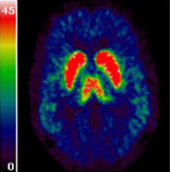PET methodology
The Wolfson Molecular Imaging Centre is a state-of-the art, purpose built facility for the development of methodology in positron emission technology and its application to research problems in oncology and neuroscience including drug development, and forms part of the University's Imaging Facilities.
Radiochemistry
The Centre has the facilities for the generation of positron emitting isotopes, using its GE PET-Trace cyclotron and extensive facilities both for the development of the radio-synthetic routes for new PET-tracers as well as the routine production of sterile radiotracers under Good Manufacturing Practice (GMP) for administration to human subjects in research projects and clinical trials. The radiochemistry facility also supplies radiotracers to other research and clinical PET centres, as far away as London.
PET Scanning
The WMIC is equipped with two PET scanners, a Siemens High Resolution Research Tomograph (HRRT) brain scanner and a Siemens Biograph PET-CT hybrid scanner. The HRRT is one of only 17 such high resolution scanners in the world. To compliment these facilities, the centre is also equipped with a Philips 1.5T MRI scanner and there is access to higher field scanners across Manchester. In support of dynamic scan data analysis, the PET scanning facilities there is a dedicated PET radio-metabolite measurement laboratory capable of the sensitive measurement of PET tracer and metabolite concentrations as a function of time during the scan. For this purpose, arterial blood is sampled and simultaneously, arterial input functions are recorded. The WMIC also has a capability for the measurement of blood flow using [15O] water, with both PET scanners.
Methodology Development
Gavin Brown; Adam McMahon; Christian Prenant.
The group have made available PET tracers labelled with 15O, 11C, 18F, 89Zr and 124I for scanning at WMIC. Further novel and published tracers are currently under development in our radiochemistry research facilities, with particular interest in imaging hypoxia, inflammatory processes, amyloid burden and the development of generic approaches for cell labelling and antibody or antibody fragment labelling. The group have expertise in the automation of radio-synthesis and their validation for clinical use under GMP. They are also involved in the development of radio-analytical methodology for tracer purification, QC and radio-metabolite measurement as well as analysis of tissue sections by MALDI-MS imaging.
Marie-Claude Asselin; Rainer Hinz; Julian Matthews.
The group is involved in the development of kinetic modelling of dynamic PET studies, the development and validation of image-derived input functions, partial volume correction methods, motion correction techniques, image resolution enhancement algorithms and their application to tumour heterogeneity measurements. For neurological studies the team have expertise in functional brain imaging: cerebral metabolic rate of glucose (CMRglu), cerebral blood flow (CBF), neuro-receptor binding and dose occupancy studies (serotonergic system, neuro-kinin 1 [NK1] receptors, adenosine 2A [A2A] receptors, translocator protein [TSPO], neuro-inflammation and microglial activation, beta amyloid).

